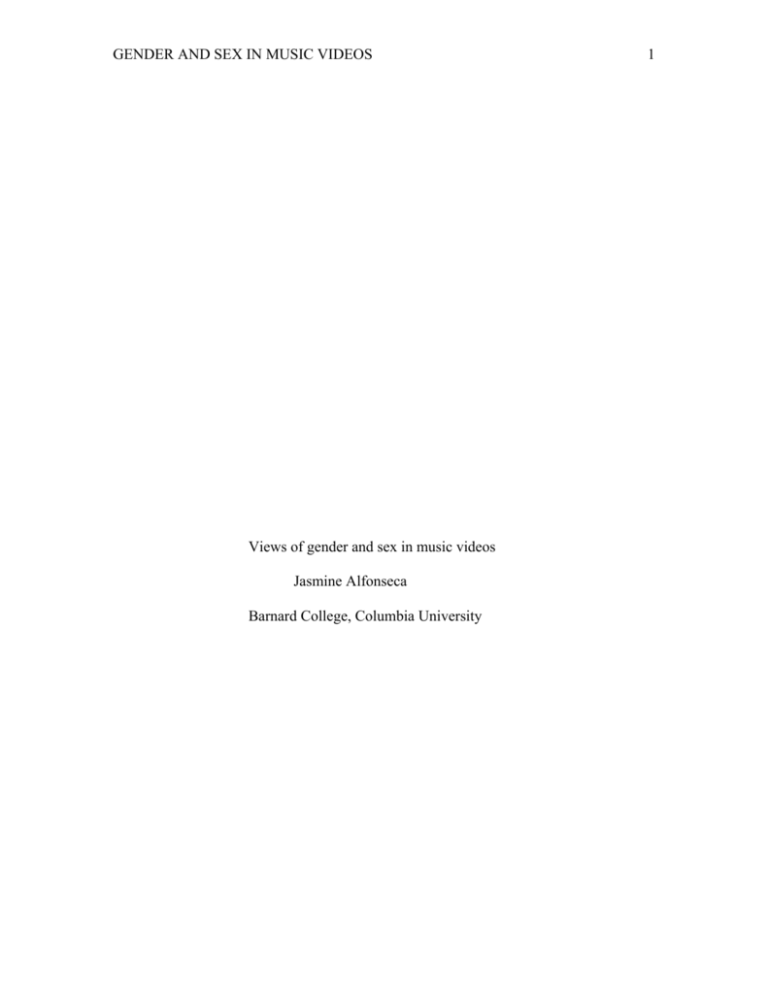
GENDER AND SEX IN MUSIC VIDEOS
Views of gender and sex in music videos
Jasmine Alfonseca
Barnard College, Columbia University
1
GENDER AND SEX IN MUSIC VIDEOS
2
Abstract
Discussed is scholarly research on the sexual content in music videos, particularly
the gender distinctions in the sexuality displayed in the visual imagery. Among those
articles are conflicting research that support the claim that women’s images are
progressing through evidence of sexual agency and power through there displayed
sexuality. This literature study examines how the highly sexual suggestiveness and
objectification of women’s bodies influences video viewers’ opinions on sex and the
function of women’s bodies. The problem, which is evident from the research, is that the
highly sexual content in music videos across genres specifically illustrates traditional
masculine ideologies of sexuality while objectifying women and using them as decorative
models. A critical analysis of what further research can be done about the traditional
views of gender and sex in music videos concludes the paper.
GENDER AND SEX IN MUSIC VIDEOS
3
Views of gender and sex in music videos
The initial purposes of music videos were to create an outlet in which artists could
expose their music to a wider audience and establish themselves as distinguishable public
figures (Andsager Roe, 2003). Yet the visual imagery, itself, in music videos has
increasingly become as popular and important as the music it portrays (Andsager et al,
2003). Music videos of all musical genres have superseded their original purpose to serve
as publicity for the artist and now influence and reflect much of young culture. Despite
the variation within lyrics, genres, and audiences, music videos continue to exhibit a onedimensional sexual content that heightens American conservative and traditional ideals of
sex and gender. Most music videos are highly saturated with sexual content that
exceedingly focuses on the masculine perspective and male pursuit of sexual satisfaction
(Ward, Hansbrough, &Walker, 2005). A females’ body is often used as decorative props
or trophies to illustrate masculine sexual desire or his power over a sexual situation.
Furthermore, women’s bodies are hyper sexualized far more than males’ bodies as a
result of the music videos’ primary focus, which is to display a masculine sexual drive
and mainstream male sexual preferences (Ward, Merriwether, & Caruthers, 2006).
American adolescents are consistently exposed to the music videos that portray
women as sexual objects and view their body parts with the single faceted purpose of
pleasuring men. In a study by Ward, Hansbrough, and Walker (2005), a sample of
African American high school students reported viewing a mean of 3.33 hours of music
videos per day, similarly to Rivadeneyra, Ward, and Gordon’s (2007) research in which
Latinos students reported watching an average of 3 hours per day of videos as well. The
increased demand and accessibility of videos by means of the internet and cable channels
GENDER AND SEX IN MUSIC VIDEOS
4
with high music video content such as BET, MTV, MTV Tr3s, and VH-1 ensures that
American adolescents and young adults are constantly retrieving misguided information
which establishes and reaffirms sex and gender bias. As they gain exposure to masculine
focused sexual content and gender bias, there is a greater demand for scholars to study
the affects of the kinds and amounts of exposure to music videos. The study of music
video content and its portrayal of females are undoubtedly essential to gaining a better
understanding of adolescents and young adults’ perspective on their physical and sexual
self-conception as well as their perceptive on each other. Therefore, it is significant to
track the perpetuating cycle of music videos in young popular culture, in which it informs
our youth about sex and gender, which they internalize as truths, and use to respond to
the environment.
Sexuality is exploited in both male and female music videos to promote an
identity or attract media and different audiences. Andsager and Roe’s (2003) threecomponent topology consists of extensive research on the studies done in the last two
decades of the twentieth century about sexual content and violence illustrated in music
videos. The first topic of the topology is Sex as Metamorphosis, “the idea of using
sexuality as metamorphosis is designed to create the illusion that an artist has evolved
into a different being, generally a more mature and edgier version of his or her former
self” (Andsager et al, 2003). Yet, this metamorphosis portrays more explicit sexuality
than adulthood or womanhood. Andsager and Roe (2003) chose Britney Spears, titled
the Princess of Pop by the media, as an example of using sex as metamorphosis in the
music video “I’m a Slave 4 U” by wearing a scarf as a top, revealing her muscular torso
and cleavage, with low-cut jeans. Her sweaty body, moist hair, and suggestive
GENDER AND SEX IN MUSIC VIDEOS
5
choreography support the idea that Brittney Spears was displaying her sexuality and
selling sex rather than showing maturity. The problem that arises from masquerading
maturity for sexuality is that viewers receive a false perception of adulthood. Young girls
are constantly exposed to their favorite young artists rapidly metamorphosing into
adulthood through the use of sex and sexuality. How exactly does sexual content
portrayed as maturity or adolescent transformation affect young girls? Even though this
question is not inquired in the study, the topology offers themes within music videos that
can be use for further research that includes young women’s internalization of the
concepts.
The second component in the topology is Sex as a Fantasy Fulfillment, which is the
use of “sexuality in ways that fulfill a fantasy for everyone” (Andsager et al, 2003).
Female artists and women in male artist music videos portray different sexual fantasy,
which are often stereotypes of a women’s role. Andsager and Roe (2003) do state that
there are women that maintain a constant image or identity, yet females are more likely to
portray different fantasy roles then males. For example, a female artist or a video vixen,
which is a woman that has appeared in several popular music videos, may have the roles
of a nurse, dominatrix, school girl, or cop, which are considered by society fantasies that
males enjoy (Andsager et al, 2003). Music videos, such 2010’s Bottles Up by Trey
Songs, depict women as objects and trophies to stare at as they are displayed in a clear
cage, with their hands held by ropes (Trey Songz Videos, 2010, 2:04) . Musical artists
such as Jay-Z, Lil Wayne, Drake, and T.I express themselves in music videos as strong
and wealthy, and their image is consistent through out each video. Yet female artists
adopt roles and wear hyper sexualized costumes, giving the impression that they can be
GENDER AND SEX IN MUSIC VIDEOS
6
anything desired or anyone in a fantasy. Yet who is the owner of these desires and
fantasies? The sexual content displayed in the fantasy role is meant for the enjoyment of
average heterosexual men. Even though, there are other viewers of distinct identities, the
music is meant to arousal the attention of the heterosexual male.
Lastly the third category of study in the topology is Sex as Power, which is
elaborates the research of French (1987), who explains that music artists use sexuality to
exude power. Specifically, male artists often use sex as a way to show power over
women and their bodies in their music videos. For example, this occurs in Bow Wow’s
“You Can Get It All” video, in which the majority of the models are wearing bikinis that
reveal parts of their buttocks as they stare and cater to Bow Wow as he raps (Bow Wow
VEVO Channel, 2010, 1:38). Although Bow Wow’s lyrics are about having a special
woman as his girlfriend in his life, he visually expresses power over the women’s bodies
in the video. He is clearly the person in charge in the video. Another current example is
Drake’s “Best I Ever Had” music video, which has women, dressed up in basketball
uniforms that look more like lingerie or sexy pajamas than traditional team uniforms,
receiving directions and motivation from their head coach Drake (Geryl, 2010, :18).
Similar to Bow Wow’s music video, Drake is expressing his interest for a woman, but his
music videos is objectifying the video vixens by focusing the lenses on their breasts
jumping as they run on the court and directing the females to stretch in provocative
positions in the locker room (Geryl, 2010, 1:21). Both rappers are extremely popular in
the Hip-Hop industry, and their music videos reflect the kinds of things depicted in
videos by multiplatinum selling artists that started before them such as Snoop Dog, JayZ, and Lil Wayne, who had done the same in videos before them.
GENDER AND SEX IN MUSIC VIDEOS
7
Further research on sex use to illustrate power, Roberts (1991) and Andsager (1999)
particularly state the idea of the power to, which certain female artist process by
controllably parading their sexuality within their terms. Female artists such as Lady
Gaga in “Poker Face,” “LoveGame,” and “Telephone featuring. Beyonce” display
explicit sexuality and sexual content, yet they always demonstrate authority over their
bodies through dance movements and being the centers of focus in the video lenses (Lady
Gaga VEVO Channel, 2010, 1:04) . For example, the camera gaze constantly follows
Lady Gaga and shows her entire body even though in the scene in Lady Gaga’s
“LoveGame” video where she is caressing two guys each representing Fame and Love
respectively while nude (Lady Gaga VEVO Channel, 2010, :15) . Although she is
pleasuring them, she continues to be in control by displaying agency in doing the
touching and looking at the camera as the men watch look at her (Lady Gaga VEVO
Channel, 2010, :17). Yet what message is the audience receiving? Do they realize that
she has control of her sexuality, or is her body only viewed in relation to giving the male
models pleasure?
In order to find any evidence that may bring what her viewers are saying about the
video to light, I visited a posting of her official “LoveGame” video on the YouTube
VEVO channel, which had 60,650,644 views as of 1pm on December 1, 2010. The video
had comments such as “I want to ride her disco stick,” “lovely ass,” and “I want to Fuck
Lady Gaga” (Lady Gaga VEVO Channel, 2010). Other YouTube users called Lady Gaga
a “slut,” “bigger whore than Brittney [Spears],” and, “this is about sex lol” (Lady Gaga
VEVO Channel, 2010). These comments respond to her display of sexuality and sexual
content but do not explain how the viewers internalize her sexual images and sexual
GENDER AND SEX IN MUSIC VIDEOS
8
power. Furthermore, it is difficult to make accurate assumptions based on these responses
without knowing anything about the users and the motivations behind the comments.
None of the comments describe Lady Gaga as a strong sexual female artist who knows
what she wants sexually and has the power to go after it. Further research should be done
to gain a deeper understanding of whether these women that try to display power over
their sexuality are actually perceived in that light.
More insight about women exhibiting power through their sexual agency is provided
by Emerson’s (2002) study, which investigates the presence of Black womanhood in
music culture through an in-depth analysis of 56 music videos including female
performers. Reasserting earlier studies that claim the objectification and exploitation of
the black female’s body along with the reinforcement of stereotypes, her argument
consists of examples of black women asserting their independence and sexual agency
(Emerson, 2002). Her examples include women artists such as Lauren Hill, Erykah Badu,
and Missy “Misdemeanor” Elliott, who display their independence, sexual agency, and
autonomy through their music and the visual imagery within the music videos (Emerson,
2002). The study expands on the idea that female performers in music videos are
increasingly defying the gender norms in the music videos by actively participating in the
creative path of the music videos and reclaiming the focus of the camera lenses to portray
women in a variety of Black womanhood roles. Emerson (2002) states that artists such as
Toni Braxton and groups like En Vogue and TLC express their opposition to be viewed
as sole objects in a male gaze by exhibiting males for their fans, and their pleasure, and
establishing a mutual ground of sexual desire. It is not substantial enough, Emerson
(2002) would agree, to state that the Black women are passively portrayed as the target of
GENDER AND SEX IN MUSIC VIDEOS
9
men’s power and sexual desire without taking into account that a woman’s desire does
become a key factor lyrically and visually, to the extent that their sexual fulfillment is
often more important than the sexual drive of the men. This provides a vehicle through
which female performers, like Janet Jackson, assert what they want and exactly how they
want to receive it.
Yet what exactly does it mean to have significant accounts of black women’s sexual
assertion and independence in music videos? How it is that research can support both
claims that music videos can objectify black women’s bodies and, under certain
circumstances, provide a space for the exhibition of their sexual agency and pursuit of
sexual fulfillment? Emerson (2002) declares that
“The results of this analysis and interpretation indicate that trade-offs are made in the
construction of an artist’s image. Black womanhood, as expressed through the Da Brat
and Missy’s performances, is the result of a process of negotiation in which
objectification of the female body must be present I order for the performer to gain a
level of autonomy, to gain exposure.”
According to Emerson (2002), the complexity between the give-and-take relationships
exposed in the music videos emerges from the fact that the black woman does not hide
her sexuality to reject exploitation but, rather, claims ownership of her body and her
multifaceted womanhood instead. Although Emerson (2002) states this contradiction as
showing “the multidimensional nature of Black womanhood,” there is a clear, superior
masculine sexual preference that most female performers adhere to. Furthermore, if the
music videos displayed the erotic sexual pleasures of both males and females, there
would be a greater variation in sexual content. The issues lies in the fact that sexual
content and gender is often one-dimensional and it’s the traditional male traditional
perceptive of what is “sexy” and preferable that drives the music video projects.
GENDER AND SEX IN MUSIC VIDEOS
10
Ciara, known for her Dance, R&B, and Pop music, in her “Ride it featuring
Ludacris” music video is at the center of the camera’s gaze without anyone else for the
majority of video in her music video (Drizzy798., 2010, :30). Her choreography, in which
she moves sexually and suggestively, is controlled by how she wants her body to move
(Drizzy798., 2010, :15). Her power is displayed by the way her dance moves not only
imply a sexual nature, but they also express discipline (Drizzy798., 2010, :30). She is
undoubtedly in control of her body, her lyrics, and the overall visual presentation that she
wants to show, which shows that she knows how to sexually pleasure a man (Drizzy798.,
2010, 1:00). Emerson (2002) may agree that she is in charge of her displayed sexuality.
However, the moment Ludacris, the featured male rapper, appears in the video, the
camera shoots multiple scenes in which they zoom into her crotch and legs, cutting off
her upper body ( (Drizzy798., 2010, 2:40). In addition, she is riding a mechanical bull
with a wet white t-shirt, which is often labeled as heterosexual fantasy by American
society (Drizzy798., 2010, 3:20). This music video is a great example of how complex
the issue is in examining music videos that appear to display what the female artist wants
as well as components of the video suggesting a contrasting interpretation. Yet some
research suggests that it matters less what type of sexual content and more about the
amount of it.
Pardum, L’Engle, and Brown (2005) make the claim that their sample 12-to-14
years old teenagers views of sex and self-conception were affected by the amount of
consumption of sexual content units in their music videos as oppose to the kind of sexual
content shown in the video. Moreover, Ward, Merriwether and Caruthers (2006) “Breast
Are for Men: Media, Masculinity Ideologies, and Men’s Beliefs About Women’s
GENDER AND SEX IN MUSIC VIDEOS
11
Bodies,” results also support the idea that male’s views of a women’s body function is
primarily influenced by the sexual content regardless if the female is showing power over
sexuality. There sample size, 656 undergraduate men aged 17 to 27, consumed an
average of 21.5 hours of music videos in which women were constantly objectified and
held decorative roles (Ward et al, 2006).Their findings show that the consumption of
sexual content in these music videos did negatively affect their views of private and
public breastfeeding and childbearing. Higher exposure to music video was related to
views of breasts as sexual rather than functional body parts (Ward et al, 2006). These
studies supports the idea that most viewers are not being influenced so much by women’s
sexual agency but by the sexual content that is supply by the women’s bodies.
The social problem with highly sexual content in music videos is that it exclusively
reflects the traditional masculine desire of sexuality and devalues women by constantly
displaying them as sexual objects. Whether female artists are showing power over their
sexuality is not as significant as the sexual content itself, which is affecting the viewers.
Further research must be done to establish a better understanding of the topic of sexual
content and gender in music videos and how it affects its viewers. There should be a clear
definition on sexual content so that exposure can be calculated accurately and precisely in
which a handful of studies utilize. In addition, future studies should investigate how the
amount of exposure to sexual content and gender bias in music videos can limit the ways
in which females and males of different age group view the functions of their body parts.
Also more input by the artists other means and outlets and more input on the age groups
that have the videos under their preferences.
GENDER AND SEX IN MUSIC VIDEOS
12
References
Andsager J., & Roe K., (2003). “What’s your definition of Dirty, Baby?” :Sex in Music
Video.” School of Journalism and Mass Communications, 79-96.
Bow Wow VEVO Channel. (2010 December 1). Bow Wow - You Can Get It All [Video
file]. Video posted to http://www.youtube.com/watch?v=9h_okYjL_E4
EMERSON A. R. (2002). “Where My Girls at?” Negotiating Black Womanhood in
Music Videos. Gender & Society, 16, 115-135
Gerry. (2010, December 1). Drake Best I Ever Had Official Video HD + Lyrics [Video
file] Video posted to http://www.youtube.com/watch?v=SX6kbN-bOkI
Lady Gaga VEVO Channel. (2010, December 1). Lady Gaga – LoveGame [Video file]
Video posted to http://www.youtube.com/watch?v=1mB0tP1I-14
Drizzy798. (2010, December 1). Ciara feat. Ludacris-Ride it official vide [Video file].
Video posted to http://www.youtube.com/watch?v=nYqIed-1BoM
Trey Songz Videos. (2010, December 1). Trey Songz - Bottoms Up ft. Nicki Minaj
Official Video [Video file]. Video posted to
http://www.youtube.com/watch?v=ekAXPCphKXQ
Rivadeneyra, R., Ward, M.L., & Gordon, M. (2007). Distorted Reflections: Media
Exposure and Latino Adolescents’ Conception of Self. Media Psychology, 9,
261-290.
Ward, L. M., Hansbrough, E., &Walker, E. (2005). Contributions of music video
exposure to Black adolescents’ gender and sexual schemes. Journal of Adolescent
Research, 20, 143-166.
GENDER AND SEX IN MUSIC VIDEOS
Ward L. M., Merriwether A. & Caruthers, A. (2006). Breasts Are for Men: Media,
Masculinity Ideologies, and Men’s Beliefs About Women’s Bodies. Sex Roles,
55, 703-714.
13









